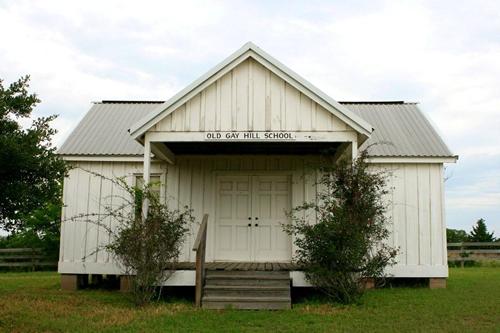The beautiful forested hills and healthy climate attracted prominent early Texans, including residents Horatio Chriesman, R. E. B. Baylor, John Sayles, and Dr. George C. Red. Horticulturist Thomas Affleck's Glenblythe Plantation was located in the Gay Hill vicinity. Old Gay Hill served as the supply point of a moderately prosperous agricultural area. In 1854 a Masonic lodge was founded there. Between 1853 and 1888 Rev. James W. Miller operated Live Oak Female Seminary in Gay Hill. By 1860 the town had flour and lumber mills and a population of 280. After the Civil War a cotton gin augmented the town's prosperity; retail establishments continued to thrive. The Masonic lodge and Presbyterian and Baptist churches were active.
The town split into "Old" and "New" Gay Hill in 1881 when the Gulf, Colorado and Santa Fe Railway laid tracks through Washington County. "New" Gay Hill is two miles west of the original site.
Thomas Gay, a partner in the local store was the namesake of the town, but his brother James Gay had a town named after him - also called Gay Hill - in neighboring Fayette County near LaGrange. Gay Hill of Fayette County is on State Highway 71 six miles southeast of La Grange. This community grew around a plantation dating back to the Republic of Texas. A third Gay Hill once existed in Milam County seven miles west of Rockdale but has since disappeared without a trace.
Gay Hill's population was 120 in 1890. By 1900 Germans were the dominant ethnic group. The town became a distribution center by the early twentieth century. Cotton buying and ginning sustained this station on the Santa Fe through the Great Depression. By 1936 Gay Hill had an estimated population of 250 and ten businesses. The nearby Sun oilfield, which opened in 1928, and its pipeline enabled the town to maintain a variety of retail and commercial establishments through the early post-World War II era. The decline of cotton and rise of ranching in the area hastened the town's demise as a distribution center and supply point. The population declined to 200 by 1958, and businesses decreased to five. The last store closed in 1971, when many residents had moved to Brenham. In 1993 the estimated population was 145, and the community had no businesses; its economy depended on ranching. It had two churches, a cemetery, and lodge hall. The population remained the same in 2000.

No comments:
Post a Comment